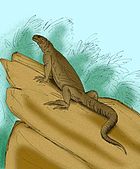Archaeovaranus
| Archaeovaranus | |
|---|---|

| |
| Holotype skull in various views | |
| Scientific classification | |
| Domain: | Eukaryota |
| Kingdom: | Animalia |
| Phylum: | Chordata |
| Class: | Reptilia |
| Order: | Squamata |
| Family: | Varanidae |
| Genus: | †Archaeovaranus Dong et al., 2022 |
| Species: | †A. lii
|
| Binomial name | |
| †Archaeovaranus lii Dong et al., 2022
| |
Archaeovaranus (meaning "ancient Varanus") is genus of varanid lizard from the early Eocene (Ypresian) Yuhuangding Formation of Hubei Province, China. The genus contains a single species, Archaeovaranus lii, known from a nearly complete skeleton. The holotype, which includes an intact skull, is associated but disarticulated. Archaeovaranus fills a gap in the varanid fossil record, as it represents a stem-varanid from the early Eocene of East Asia, and is the closest known relative of Varanus.[1]
Discovery and naming
The holotype specimen of Archaeovaranus, IVPP V 22770, was discovered at the Dajian locality of the Yuhuangding Formation near Danjiangkou, Hubei Province, China.[1]
The generic name, "Archaeovaranus," combines the Greek "archaīos," meaning "ancient," with a reference to the closely related Varanus.[1] "Varanus" is derived from the Arabic "waral," meaning "lizard beast."[2] The specific name, "lii," honors the paleontologist Chuankui Li, whose research included studies of the Archaeovaranus type locality.[1]
Description
The holotype specimen represents an adult individual, around 16 years old at the time of death. However, a lack of fusion at the distal ends of the humerus and femur suggest that the individual was still growing. The body size is approximately equivalent to Varanus salvator.[1]
Taxonomy
Archaeovaranus was found in the study to be the closest known relative of modern monitor lizards belonging to the genus Varanus.[1]
Cladogram after Dong et al. 2022.[1]
Paleoecology
The mammals Rhombomylus, Advenimus, Asiocoryphodon and Danjiangia are also known from layers of the Yuhuangding Formation.[1]
References
- ^ a b c d e f g h Dong, Liping; Wang, Yuan-Qing; Zhao, Qi; Vasilyan, Davit; Wang, Yuan; Evans, Susan E. (2022-03-28). "A new stem-varanid lizard (Reptilia, Squamata) from the early Eocene of China". Philosophical Transactions of the Royal Society B: Biological Sciences. 377 (1847): 20210041. doi:10.1098/rstb.2021.0041. PMC 8819366. PMID 35125002.
- ^ Robert George Sprackland (1992). Giant lizards. Neptune, NJ: T.F.H. Publications. p. 61. ISBN 0-86622-634-6.




